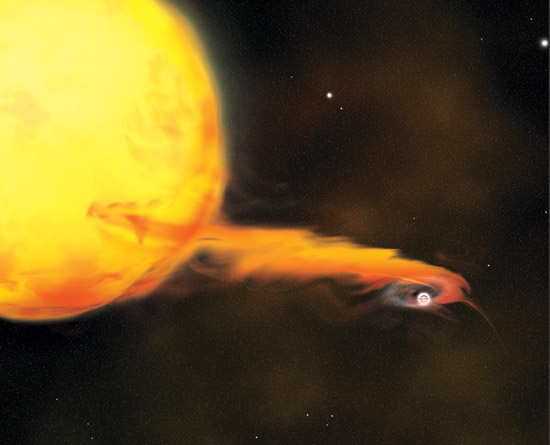Evan Ackerman
(dvice)
(dvice)
NASA, for some reason that the agency has chosen not to share, is quite interested in just exactly what it takes to set off a Type Ia supernova. Thanks to a series of X-ray and ultraviolet observations from the SWIFT satellite, NASA says that “we have a clearer picture of what’s required to blow up these stars.” Oh, good.
Type Ia supernovae are a specific type of stellar explosion that are very, very important because astronomers can use them as what’s called “standard candles.”
Standard candles (there are only a few different kinds and they’re all very rare) are things that we can see with a telescope and know how far away they are. Usually, if you see something through a telescope, there’s no reliable way of knowing whether it’s a bright thing that’s far away or a dim thing that’s up close. A standard candle has a luminosity (or, an intrinsic brightness) that doesn’t ever change, so based on how bright or dim it looks to us here on Earth, we can figure out how far away it (and everything around it) actually is.
With Type Ia supernovae, the standard candle is a white dwarf star that blows up. We know a fair amount about white dwarfs themselves: they’re main-sequence stars (like our sun) that have used up all of their fuel and collapsed into a white blob about the size of the Earth, glowing thanks to stored-up leftover heat. Made up mostly of carbon and oxygen, white dwarfs can’t undergo fusion on their own, so they just sit there and slowly cool off until eventually they stop putting out any light at all.
Sometimes, though, a white dwarf will have a companion star, as part of a binary system. And though the white dwarf is very small for a star, it still has star-like gravity, and it’ll start sucking up material from its companion.
If it manages to steal enough stuff, at a certain point the white dwarf will be hot enough to start fusing its own carbon, and within the space of a few seconds (yes, seconds) a runaway fusion reaction will chew through most of the dwarf’s carbon and oxygen, turning them into heavier elements and releasing a whole bunch of energy. By a whole bunch of energy, we’re talking 10^44 joules, which equates to about 5 billion times the amount of energy that our sun is putting out at any given time. The poor little white dwarf, needless to say, cannot survive this, and it explodes violently enough to be visible across the universe. And since that “certain point” where a white dwarf is big enough to go nova is the same for every white dwarf everywhere, they always explode in the same way with the same brightness, which is how we can calculate how far away they are.
What nobody knew until recently was what the deal is with the trigger star: the binary companion that enables white dwarfs to collect enough mass to set themselves off. Astronomers have had a few guesses, but the conventional thinking was that the most common companions are red and blue giants, and occasionally companion white dwarfs would smash into each other. NASA’s SWIFT satellite, which was designed to spot gamma ray bursts, has been used to check out supernovas and supernova remnants, looking for clues about the companion stars. Instead of finding evidence for giant stars, the SWIFT observations suggest that most supernova triggers are caused by stars similar to our sun (or even smaller), and the white dwarf on white dwarf scenario seems much more likely as well.
So what does this all mean? Basically, it means that NASA’s pretty sure that if the agency could just drag a white dwarf over to our Sun, it’d have no trouble setting off a Type Ia supernova. Wonderful, glad we’ve got that all figured out — thanks, NASA!

No comments:
Post a Comment